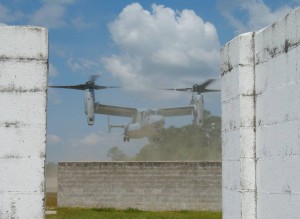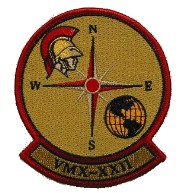2012-12-12 In the first piece from our interview with Col. Michael Orr, VMX-22 squadron commander, we focused on the co-location of the F-35 squadrons, MAWTS and VMX-22 and its impact on innovation. In this second part, Col. Orr discusses some of the consequences of having such a process in place.
As Col. Michael Orr, the CO of the squadron underscored, “we are testing platforms working together in shaping capabilities. We are not just testing individual platforms. This is especially crucial when you have dynamic, transformational platforms such as the Osprey and the F-35.”
http://www.aviation.marines.mil/Leaders/tabid/490/Article/129309/colonel-michael-r-orr.aspx
SLD: You are an F/A-18 pilot, but the Osprey and the F-35 could not be more different from an F/A-18. Your background mixed with the two new planes will be an interesting experience for you.
And your background will be important to understanding as well the changes, which can be and needed to be made.
Col. Orr: You look at things differently when coming in from another community. I look at the way the airplanes perform together, or don’t perform together and I see lots of room for improvement.
What I’m very, very excited about is just a tremendous future for the V-22 Osprey in a role as as the cornerstone of the power projection capability of the aviation combat element of the future. I’m particularly interested in initiatives to increase the utility and lethality of the aircraft.
It’s way, way more than a platform to haul Marines and equipment from one place to another. It can do that mission very, very well. It’s proven it can do that in two combat theatres, and now it’s time to think about what else this aircraft can do.
And when you start to think about roll on/roll off packages, for example, what you see what we’re doing with the C-130 Harvest Hawk, it opens up a world of possibilities. Signals intelligence, electronic warfare, aerial refueling, are all the kind of things that you can do with the platform.
When you start to think about having that capability paired up with the F-35 on an L Class ship in the future, it’s a very, very exciting time for Marine Aviation.
SLD: Clearly the Osprey is not as well connected to the rest of the force as it could be and the F-35 has C2 capabilities, so I would assume that a key part of what you are looking at is the dynamic growth over time in the ability of the ACE to work together in conjunction with the ground and sea elements?
Col. Orr: That is really the sweet spot of the innovation our unit we will be focusing on. My experience in the F/A-18 world has demonstrated what a robust link network can do to increase war fighting capability.
I think about bringing some of warfighting benefits that come from increased battlespace awareness to the entire aviation combat element, and not just the strike and fighter elements.
Think about what you can do if you have linked situational awareness, not just between individual aircraft of the ACE, but also of the supported ground component commander that’s riding in your aircraft.
By using systems to increase the MAGTF commanders’ situational awareness, we will see revolutionary improvements to the synergy across the MAGTF and Joint force.
For VMX-22, our vision is to be that organization that brings together all of those different pieces and parts of the ACE for the express purpose of driving new tactics, new concepts for employment, and information sharing for effective decision-making.

SLD: And your work at Yuma will be to facilitate putting the new assets into the hands of the MAGTF commanders as well as the Combatant commanders. It is not just testing for testing’s sake!
Col. Orr: That is correct. The Marine Corps’ desire to see these increased capabilities fielded successfully and as rapidly as possible is rooted in the reality that once you get more capable platforms and systems in the hands of Marines supporting Combatant commanders, our service will be in a much better position to perform our varied missions.
In the past, when we thought about system of systems, we limited our discussions to a particular aircraft platform, but we really need to expand that system of systems to think about the entire kill chain or decision-making chain, not just the individual platform.
The idea of bringing all of the MAGTF ACE platforms under one organization to do the testing is really the point. Standalone platform testing does not get you where you need to go to achieve that synergy.
How do we ensure that the game changing F-35 sensors work well with the existing technology that we have out there in the battle space?
With VMX-22 and MAWTS collocated, we can create a very symbiotic relationship where MAWTS gets a peak at the future technologies and helps develop tactics as VMX-22 tests emerging systems.
We’ve got an early start with our support to the F-35 development. Our pilots are participating in the software development process for the F-35 as well as providing the pilot warfighting perspective on the evolution of a software upgradeable plane.
SLD: How do you see the intersection of the three groups enhancing the innovation process?
Col. Orr: I think that one of the key advantages of bringing all the communities of the MAGTF ACE together under a single roof is that you start to really draw on the best practices and ideas from each platform.
We’re all victims of our own experience,, but somewhere in each of our different communities, there are nuggets of genius that each of us can contribute.
We’ve got to be able to bring all those platforms together and in the right spaces with the right clearances that allow us to fully share information. I think it’s going to be an exciting place to be.
I’m recognizing that I’m simply laying the building blocks and the groundwork for this future organization. It will take time to bring these different test activities together, and I will probably pass the football over to somebody else to take it across the end zone and score the winning touchdown.
I see this unit serving as a laboratory to develop best practices and yet still account for the complexity of the individual weapon systems that we’re testing.
Beyond interoperability of systems, we will also be focusing on maintainability and supportability of the weapon platforms.
One obvious challenge is how to gain efficiency as we put together our composite maintenance and support teams.
An added benefit to a permanent composite squadron is the ability to develop best maintenance practices and then share those best practices with fleet units. As we think about the F-35 and some of the challenges it’s going to bring from an aircraft maintenance perspective, we can focus on how to build a composite maintenance department for future fifth generation and legacy aircraft.
For the first piece of this two-part series see the following:
https://sldinfo.com/vmx-22-comes-to-yuma-the-third-leg-of-the-dynamic-development-of-the-f-35-b/



